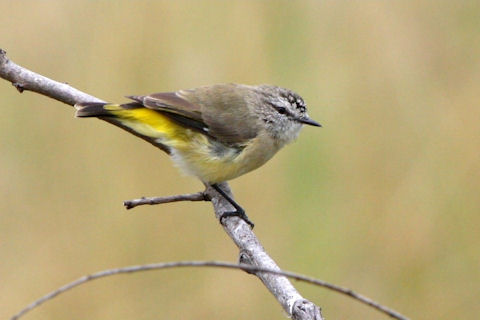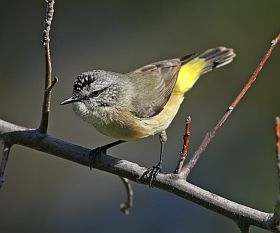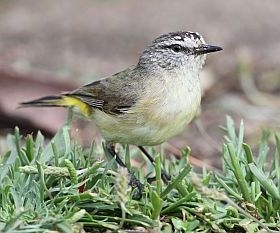
Acanthiza chrysorrhoa
SUBFAMILY
Acanthizinae
TAXONOMY
Acanthiza chrysorrhoa Quoy and Gaimard, 1830, New South
Wales, Australia.
OTHER COMMON NAMES
English: Yellow-tailed thornbill, tom-tit; French: Acanthize а
croupion jaune; German: Gelbbьrzel-Dornschnabel; Spanish:
Acanzisa de Cola Amarillo.
PHYSICAL CHARACTERISTICS
4 in (10 cm); 0.32 oz (9 g). Characterized by a bright yellow
rump, black crown spotted white, and white brow.
DISTRIBUTION
Southern and central Australia, including Tasmania.
HABITAT
Open woodland and edges, farmland and grassland with scattered
trees or bushes, parks and gardens.
BEHAVIOR
Typically in family groups or small flocks, often with other
thornbills. Active and noisy, with twittering songs and calls.
Yellow rump very conspicuous in flight so that bird almost disappears
when it lands. Sedentary or local movements only.
FEEDING ECOLOGY AND DIET
Primarily ground feeding, taking insects, other arthropods and
sometimes seeds. Occasionally forages on shrubs and low trees.
REPRODUCTIVE BIOLOGY
Breeds from July to December, occasionally later. Domed nest
is placed in a bush or sapling. Typically made of grass, lichen,
and other plant fibers. The true entrance is at the side, and
concealed by a hood, but there is a false cup-shaped nest
placed on the top, possibly to confuse predators or cuckoos.
Two to four pink eggs, lightly speckled. Both parents build
nest, but only female incubates. Incubation period of 18–20
days, fledging period of 17–19 days. Parents are often assisted
by helpers. Many nests fail due to predation or are parasitized
by bronze-cuckoos.
CONSERVATION STATUS
Not threatened.
SIGNIFICANCE TO HUMANS
A well-known bird to many country dwellers.
Photo Gallery of - Yellow-rumped thornbill




 Animalia Life
Animalia Life